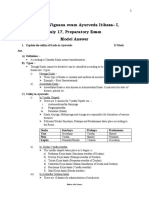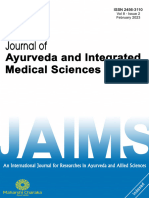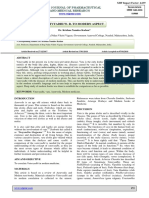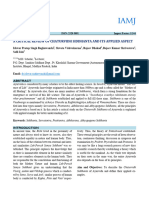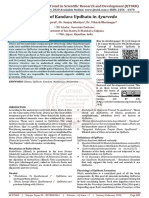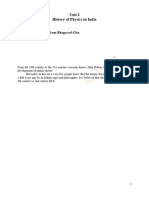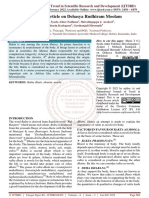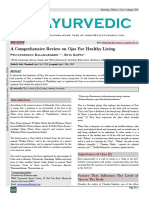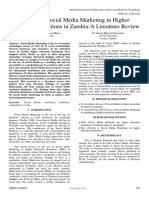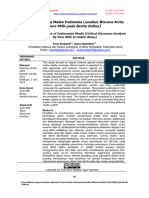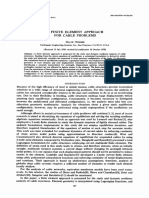Concept of Tridosha Theory: A Critical Review: Introduction
Concept of Tridosha Theory: A Critical Review: Introduction
Uploaded by
Muhsina BasheerCopyright:
Available Formats
Concept of Tridosha Theory: A Critical Review: Introduction
Concept of Tridosha Theory: A Critical Review: Introduction
Uploaded by
Muhsina BasheerOriginal Description:
Original Title
Copyright
Available Formats
Share this document
Did you find this document useful?
Is this content inappropriate?
Copyright:
Available Formats
Concept of Tridosha Theory: A Critical Review: Introduction
Concept of Tridosha Theory: A Critical Review: Introduction
Uploaded by
Muhsina BasheerCopyright:
Available Formats
www.ijcrt.
org © 2021 IJCRT | Volume 9, Issue 1 January 2021 | ISSN: 2320-2882
CONCEPT OF TRIDOSHA THEORY : A
CRITICAL REVIEW
Dr.Savita, 2ASHOK KUMAR SHARMA
1
1MD Scholar, 2Proffesor & HOD,
1
Department of Kriya Sharir, MMM Govt. Ayurveda College, Udaipur,
2Department of Kriya Sharir, MMM Govt. Ayurveda College, Udaipur
Abstract - Ayurveda is a systematic and remarkable view of life founded on understanding.Unveiled by empirical
comprehension of the law of nature.The tridosha theory in Ayurveda has been said to have derived from the theory of the three
elements of the universe.All physiological and biological functions of human body are regulated by these tridosha. The names
of these three doshas, which are roughly equivalent to humour, are vata (wind), pitta (bile), and Kapha (phlegm), corresponding
to the three elements of the universe: air, fire, and water. A human being's stable and unhealthy state depends on the usual
and abnormal functional state of the person. Tridosha, considering Dosha's physiological significance in preserving the
body's homeostasis, Tridosha have been called as root (Dosha Dhatu Mala Moolam hi Shariram) of the body. All the
functions of the body could be explained in terms of Dosha, Dhatu and Mala. : One of Ayurveda's specific theories is said
to be Tridosha siddhanta. Tridosha works and controls each other and controls each other together and Maintaining the
body's balance.The actions of tridoshas are quiet natural because all are identical in origin and they originate together in
the body. . In present article the role of Tridosha will be discussed in terms of regulation and expression of these characteristics
distinction in living being.
keywords - Ayurveda,vata,pitta,kapha,tridosha
Introduction:-
The ancient medical science that has been prevalent on the Indian subcontinent for thousands of years is
Ayurveda. One of the main fundamental theories of Ayurveda involves a method of understanding health
and illness known as the tridosha.(1) It is assumed that Ayurveda is a science that imparts Not just physical,
but also spiritual (mental) and psychological well-being. Ayurvedic, according to Philosophy, the
foundations or base of the body, responsible for its formation, are considered to be Tridoshas, Preserving
and killing.(2)
This concept of tridosha involving the three doshas of vata, pitta, and kapha is a central doctrine of
Ayurveda and follows from the first chapter of the earliest text on Ayurveda, the Charaka Samhita.(3)
Tridosa ('Tri'= three+' Dosa'= vitiation-capable) is an Ayurvedic idea, It consists of three fundamental
biological energies, namely Vata, Pitta and Kapha. The dosas are responsible for homeostasis and health
of living beings. When these energy forces are in equilibrium the living beings are in a normal health status
and when they are deviate produce diseases.(4) Ayurveda has considered that the balanced state of Dosha,
Dhatu and Mala leads to state of health and their imbalanced state produces disease. (5) This state of
Equilibrium is not only preserved by The specified number, but also the quality (functional state) of such
IJCRT2101265 International Journal of Creative Research Thoughts (IJCRT) www.ijcrt.org 2184
www.ijcrt.org © 2021 IJCRT | Volume 9, Issue 1 January 2021 | ISSN: 2320-2882
variables, i.e. Dosha,Mala and Dhatu.(6) The state of health has been defined as the presence of equilibrium
in activities of Dosha, Agni, Dhatu, Mala and calm and pleasant state of soul, sense organ and mind.(7)
The tridoshas are various forms of energies, vata = kinetic energy, pitta = thermal energy, kapha =
mechanical energy. The balanced condition of these energies maintains the health status of the individual.
It is clear that It deals with science related to existence and Life expectancy. It has some perceptible
hypotheses To frame the meaning of Ayurveda, in the The pivotal principle is Tridosha. . Body is
constituted by Akasha, Vayu, Agni, Ap and Prithvi Mahabhuta which are known as Panchamahabhuta. (8)
The Material that executes all corporal acts / complex actions As vata is named in the body. Thermal-
related heat Potential produced by controlled substances / heat potential The pita and the liquid, the liquid
produced and the liquid generated, are called The liquid mediated components are known as the kapha. .
In the panchabhoutik world / body, the laghavaguna yukta akasha combines with vayu and nourishes the
vatha dosha, agni mahabhuta nourishes the pita dosha and gouravaguna yukta bhoomi along with jala
nourishes the kapha dosha. Creation, transformation& well-being and The human body's degradation is
carried out by the combined acts of the vata, pita, and kapha beginning From birth until death, not leaving
a single body cell. Doshas are panchabhotik dravyas(physical objects).(9) Doshas acts as the samavayi
karana for roga and arogya.(10)
The Vata, pita, and kapha nomenclature to the doshas themselves Denotes his imaginative actions. The
word vata is originated from “va” Dhatu which means gati / gandhana. The gati arthaka dhatus gives 3
meanings gati (means movement), gnana (grasping the knowledge) and prapti (reaching or achieving).
Gandhana implies uthsaha (enthusiasm for doing the works), prakasa (expression), soochana (taking
towards), himsa (leading to destruction). The word pita is originated from “tap” Dhatu which means santapa
(for paka and sara kitta vibhajana), daha (dahana karma leading to parinama), aishwaya (the prospirity).
The word kapha is originated from the “shilsh” Dhatu which implies the functions like shleshana or
poshana.(11)
Therefore, doshas are defined as one that It brings the body to motion and stabilizes it. Therefore, Tridoshas
Specialized panchabhotik compounds that are supposed to be"To render a "functional" body.
Material & Methods:-
.For the current research each and every context related to topic will be taken as source of material from
Brihatrayi, Laghutrayi and all available full commenteries.
. On the basis of all information and collected data subject has been discussed with knowledgeable persons
and after discussing systematically it has been concluded in brief. Biological Characters of all living Being
and Functions of Tridosha can be corelated.Comparing functions of Tridosha with Biological characters
the role of Tridosha in living being could be explained.
IJCRT2101265 International Journal of Creative Research Thoughts (IJCRT) www.ijcrt.org 2185
www.ijcrt.org © 2021 IJCRT | Volume 9, Issue 1 January 2021 | ISSN: 2320-2882
Definition:-
a) Dooshayanti iti Dosha/those which vitiate the other substances after getting themselves vitiated.
b) Dustimgatva Vyadhim Janayanti Iti Dosha/ those which produce disease when vitiated.
Theory of Samya (Equilibrium): -
Acharya Vagbhatta has been stated that Doshasamyam Arogyata (12) and Acharya Charaka inscribed
“VikaroDhatu Vaishamya”(13) , while describing the heath and disease. Samyavastha is balanced and
normal state of Doshas leading to health.
Table no.1.- Relationship between Doshas and their Gunas, Panchabhautikata:-
DOSHA S.NO. PROPERTIES COMPOSITION OF
PANCHMAHABHUTAS
Vata 1. Ruksha Prithvi,Agni,Vayu
2. Sheeta Jala
3. Laghu Vayu,Akash,Agni
4. Sukshma Vayu,Agni,Akash
5. Chala Vayu,Akash
6. Vishada Prithvi,Vayu,Agni,Akash
7. Khara Prithvi,Agni,Vayu
Pita 8. Sneha Prithvi,Agni,Vayu,Jala
9. Ushna Agni
10. Tikshna Agni
11. Drava Jala
12. Sara Jala
13. Amla Prithvi,Agni
14. Katu Agni,Vayu
Kapha 15. Guru Prithvi,Jala
16. Sheeta Jala
17. Mridu Jala,Akash
18. Sneha Jala
19. Madhura Prithvi,Jala
20. Sthira Prithvi
21. Picchila Jala
IJCRT2101265 International Journal of Creative Research Thoughts (IJCRT) www.ijcrt.org 2186
www.ijcrt.org © 2021 IJCRT | Volume 9, Issue 1 January 2021 | ISSN: 2320-2882
The Tridosha includes:-
1.Vata
2.Pita
3.Kapha
Vata – the Catabolic Dosha:-
This Dosha is formed by a combination of wind and space.the basic characteristic of the Dosha is
movements, be it physical or spiritual. The Dosha controls the flow of neural impulses.Also, the Vata
performs a major function of controlling the other two Doshas. The first focus of the Dosha is to constantly
maintain a balance between all the three Doshas. Further, the Vata Dosha has five sub-Dosha which
include.
a) Prana Vata is found in the head and it controls the senses.
b) Vyana Vata controls all the controlled bodily action and is found in the heart.
c) Udana Vata is found in the chest area and it controls the voice and intellectual abilities.
d) Samana Vata is present in the stomach and it controls the digestive processes.
e) Apana Vata controls all the discharges through the urinary tract and is found in the anal region.
Pitta – the Metabolic Dosha:-
Formed by a combination of fire and water, Pitta Dosha governs all the processes related to metabolism
and changes (mental and physical) that occur in the body. The major functions performed by the Dosha
include digesting food and further using it make energy for the body. The Dosha is further divided into five
sub-categories:
a) Ranjak Pitta produces Rakta or blood and is found in the stomach.
b) Bhrajak Pitta controls skin pigmentation and is found in the skin.
c) Aalochak Pitta is found in the eyes and controls the sight.
d) Sadhak Pitta is present in the heart and it governs the psychological capabilities of the body.
e) Pachak Pitta controls the digestive functioning of the body and is found in the duodenum part of
the small intestines.
IJCRT2101265 International Journal of Creative Research Thoughts (IJCRT) www.ijcrt.org 2187
www.ijcrt.org © 2021 IJCRT | Volume 9, Issue 1 January 2021 | ISSN: 2320-2882
Kapha – Anabolic Dosha:-
Earth and water together make Kapha, the anabolic Dosha. The most important function of the Kapha
Dosha is to provide energy to the mind and body. The Dosha also controls the amount of water in the body
and fills up those parts that have less water, till the cellular level. The Dosha also plays an important
function at the psychological level where it is linked with emotions like envy and love. Kapha is further
sub-classified into:
a) Kledak Kapha is found in the stomach and works to digest the food.
b) Shleshak Kapha is present in all joints of the body and controls the lubrication of joints.
c) Tarpak kapha is found in the head and controls intelligence.
d) Bodhak Kapha is found in the sensory organ of taste and governs the same.
e) Avalambak Kapha is present in the chest and it lubricates the heart and throat.
Disscussion:-
Tridosha exist in only living body not in dead. After death only Panchamahabhuta remains there, whenever
the Chetana Dhatu conjugated with Panchamahbhuta resulted into exhortation of three Mahabhutas Vayu,
Agni and Jala to build and sustain the body.
Vata is the primal constituent of the living body, composed by Akasha and Vayu(14) Mahabhuta and whose
function is Rajasic.(15) It relates to the development of such systems that are somatic and psychic The
existence of Vata is therefore to be inferred in such mental phenomenon as the show of excitement, which
is primarily Rajasic or dynamic in nature, Emphasis etc.It upholds all the supporting constituents and their
due circulation throughout the body.(16)
Pitta is that primal constituent of the living body, composed by Tejas(17) Mahabhuta and whose function is
Satvic(18) as The development of those physical ones is concerned with And mental structures. Which in
nature are primarily satvic (balancing and transformative).
Kapha is that primal constituent of the living body whose structure is composed by Apa and Prithvi
(19)
mahabhuta and whose function is Tamasic,(20) as It is of importance With the development of those
physical and Mental procedures, which are primarily In nature, Tamsic (Conserving and Stabilizing). And
hence plays the important role in maintaining health of the body.
IJCRT2101265 International Journal of Creative Research Thoughts (IJCRT) www.ijcrt.org 2188
www.ijcrt.org © 2021 IJCRT | Volume 9, Issue 1 January 2021 | ISSN: 2320-2882
Conclusion:-
Tridosha exist only in living body. In non– living Tridosha doesn’t exist. Each and every cell of the body
is made up of the tridosha. Tridosha theory regulates all the mechanisms.
The theory of tridosha is a derivative of the previously mentioned theory of panchmahabhut. The theory of
tridosha forms the basis of Ayurved. They are under the influence of three basic elements or particles
known as Vata, Pitta and Kapha. Despites of the fact that Tridoshas are also Panchbhautic (i.e. made up of
five basic elements Panchbhutas) still there is predominance of Vayu and Akash in Vata, predominance of
Agni in Pitta and predominance of Jala and Prithvi in Kapha. Given the significance of the theory of
tridosha, all the details of tridosha need to be understood.
In present work, we studied all related available literatures and found that Tridosha theory is not only
physiological unit of human being but also effects whole cosmos, as a functional unit.
References:-
1. Hankey A. The scientific value of Ayurveda. J Alt Complement Med. 2005;11:221–5.[Google
Scholar]
2. Balkrishna A. A practical approach to the science of ayurveda: a comprehensive guide for healthy
living. Haridwar, India: Divya Prakashan, Divya Yoga Mandir Trust. 2013.
3. Sharma PV, editor. 4th ed. Ch. 1. Varanasi: Chowkambha Sanskrit Series, Chaukambha Orientalia;
1981-86. Charaka Samhita. [Google Scholar]
4. Acharya B. A practical approach to the science of ayurveda: a comprehensive guide for healthy
living. 1st ed. Haridwar: Divya Prakasam Divya Yog Mandir Trust 2013.
5. Sharma R.K., Das B, editor, (reprint edition). Charaka Samhita of Agnivesha, Sutrasthana;
Khudakchatushpadam Adhyaya: Chapter 9, verse 4. Varanasi: Choukhmbha Sanskrita Series office
2014; p.184.
6. Sharma R.K., Das B, editor, (reprint edition). Charaka Samhita of Agnivesha, Sharirasthana;
Sharirvichayashariram: Chapter 6, verse 4. Varanasi: Choukhmbha Sanskrita Series office 2014;
p.426.
7. Murthy Shrikantha K.R. editor, (reprint edition). Susruta Samhita of Sushruta, Sutra Sthana; Dosha
dhatu mala kshaya vriddhi Adhyaya: chapter 15, verse 41. Varanasi: Choukhambha Orientalia
2014; p. 110.
8. Dwibedy, L.D. and Dwibedy, B.K., Goswami, P.K. Vol.1 to 4. Caukhamba Ayurveda series office,
Varaṇasi, Caraka Saṃhita, Sharirsthan 1/16
9. Vagbhata Ashtanga Sangraha Sutrasthana 17/1,3rd edition, Varanasi, Chowkhamba Krishnadas
Academy, reprint 2012,page no 135.
IJCRT2101265 International Journal of Creative Research Thoughts (IJCRT) www.ijcrt.org 2189
www.ijcrt.org © 2021 IJCRT | Volume 9, Issue 1 January 2021 | ISSN: 2320-2882
10. Vagbhata Ashtanga Hridaya Sutrasthana 1/20, 2003, Varanasi, Chowkhamba Krishnadas
Academy, reprint 2003,page no 12
11. Susrutha Samhitha Sutrasthana 21/5, 2nd edition, Varanasi, Chowkhamba Krishnadas Academy,
reprint 2003,page no 8
12. Shashtri Paradakara Bhiṣagacharya, Pandit Hari Sadasiva, Ninth edition, 2002. Aṣtanga Hridaya -
with the commentaries, Sarvangasundara of Aruṇadatta and AyurvedaRasayana of Hemadri,
Caukhamba Orientalia, Varanasi, Sutrasthan 1/20
13. Dwibedy, L.D. and Dwibedy, B.K., Goswami, P.K. Vol.1 to 4. Caukhamba Ayurveda series office,
Varaṇasi, Caraka Saṃhita, Sutrasthan 9/4
14. Vagbhatta, Astang Sangraha Sutra Sthana, Dr. R. Vidhyanath Pub. Chaukhambha Surbharti
Prakashan, Varanasi, edition 1st 2006 (A.S. Su. 20/3)
15. Sharangdhar samhita hindi commentary, tattva dipika by Pt. Durgadutta Shastri, Publication
Chaukhambha Vidhya Bhawan Varanasi 2002 (Sh. P. A. 5/26)
16. Agnivesh, Charak Samhita Sutrasthan texts with English translation and critical exposition based
on Cakrapani Datta's Aryuveda Dipika Dr. R.K. Sharma Bhagwan Das, Pub. Chaukhambha
Sanskrit Series office Varanasi India (Ch. Su. S. 18/51)
17. Vagbhatta, Astang Sangraha Sutra Sthana, Dr. R. Vidhyanath Pub. Chaukhambha Surbharti
Prakashan, Varanasi, edition 1 st 2006 (A. S. S. 20/3)
18. Sharangdhar samhita hindi commentary, tattva dipika by Pt. Durgadutta Shastri, Publication
Chaukhambha Vidhya Bhawan Varanasi 2002 (Sh.P. A. 5/29)
19. Vagbhatta, Astang Sangraha Sutra Sthana, Dr. R. Vidhyanath Pub. Chaukhambha Surbharti
Prakashan, Varanasi, edition 1st 2006 (A. S. S. 20/3)
20. Sharangdhar samhita hindi commentary, tattva dipika by Pt. Durgadutta Shastri, Publication
Chaukhambha Vidhya Bhawan Varanasi 2002 (Sh. P.S. 5/33)
IJCRT2101265 International Journal of Creative Research Thoughts (IJCRT) www.ijcrt.org 2190
You might also like
- Dosa Dhatu and MalaDocument15 pagesDosa Dhatu and MalaShikha MankotiaNo ratings yet
- Physiological Concept of Loka Purusha Samya Siddhanta - March - 2023 - 3984741346 - 5214579Document2 pagesPhysiological Concept of Loka Purusha Samya Siddhanta - March - 2023 - 3984741346 - 5214579Akshay MNo ratings yet
- A Conceptual Study of Updhatu in Ayurveda: Innovation Journal September 2019Document5 pagesA Conceptual Study of Updhatu in Ayurveda: Innovation Journal September 2019RamamurthyNo ratings yet
- Ayurveda y JyotishDocument7 pagesAyurveda y JyotishPedro PerezNo ratings yet
- PV 1 Prep July 17 Model AnsDocument13 pagesPV 1 Prep July 17 Model AnsVijay Banakar ChannahalliNo ratings yet
- 22 Ijmtst0708032-1Document5 pages22 Ijmtst0708032-1Chukno ChuknoNo ratings yet
- Nadi Good Review Paper 2281-Article Text-5330-1-10-20230325Document7 pagesNadi Good Review Paper 2281-Article Text-5330-1-10-20230325raghav.e16302No ratings yet
- Critical Stdy Eye PDFDocument7 pagesCritical Stdy Eye PDFRahimshaikhNo ratings yet
- Aasthi Pardoshaj VikarDocument6 pagesAasthi Pardoshaj VikarSahil KaushikNo ratings yet
- VaisheshikaDocument9 pagesVaisheshikaphilolibraryruhalayaNo ratings yet
- A Review On Trividha Hetu With Special Reference To Prajnaparadha - December - 2021 - 1605998327 - 0402445Document3 pagesA Review On Trividha Hetu With Special Reference To Prajnaparadha - December - 2021 - 1605998327 - 0402445Fabio GoulartNo ratings yet
- Ayurvedic Concepts of Metabolism - Dhatuparinama PDFDocument36 pagesAyurvedic Concepts of Metabolism - Dhatuparinama PDFAnonymous 2gu2TzNo ratings yet
- Shirovirechnopaga Mahakashaya in Urdhwajatrugata Roga A Literary Review - February - 2024 - 8880371783 - 7602305Document2 pagesShirovirechnopaga Mahakashaya in Urdhwajatrugata Roga A Literary Review - February - 2024 - 8880371783 - 7602305superhitmelodyNo ratings yet
- Article 1519801601Document4 pagesArticle 1519801601Graziela SpadariNo ratings yet
- The Conceptual Study of Ayurvedic Pathya - Apathya Kalpana in Vikaar Caused by VishaDocument6 pagesThe Conceptual Study of Ayurvedic Pathya - Apathya Kalpana in Vikaar Caused by VishaAnonymous CwJeBCAXpNo ratings yet
- Conceptual Study of Purusha Siddhant in Ayurveda and Its Relevance With Scientific ApproachDocument5 pagesConceptual Study of Purusha Siddhant in Ayurveda and Its Relevance With Scientific ApproachIJRASETPublicationsNo ratings yet
- Pain Management in Amavata With Rasnasapataka KashayaDocument3 pagesPain Management in Amavata With Rasnasapataka KashayaEditor IJTSRDNo ratings yet
- A Review Article On Types of Dhatu-Kshaya DepletioDocument5 pagesA Review Article On Types of Dhatu-Kshaya DepletioPNo ratings yet
- International Ayurvedic Medical JournalDocument6 pagesInternational Ayurvedic Medical JournalcommonentrancecoverageNo ratings yet
- A Birds's Eye View of Dhatu SamyataDocument4 pagesA Birds's Eye View of Dhatu SamyataNutty BunnyNo ratings yet
- Concept of Kandara UpDhatu in AyurvedaDocument4 pagesConcept of Kandara UpDhatu in AyurvedaEditor IJTSRDNo ratings yet
- A Physiological Study of Rakta Dhatu: World Journal of Pharmaceutical and Medical ResearchDocument5 pagesA Physiological Study of Rakta Dhatu: World Journal of Pharmaceutical and Medical ResearchCocoluhNo ratings yet
- Review Study of Nidra As Per AyurvedaDocument3 pagesReview Study of Nidra As Per AyurvedaEditor IJTSRDNo ratings yet
- Shabda As Vishesh Guna of Akasha Mahabhuta - A Critical ReviewDocument7 pagesShabda As Vishesh Guna of Akasha Mahabhuta - A Critical Reviewrachel.matos.walterNo ratings yet
- Some Important Aspects of Nadipariksha From BasavarajiyamDocument3 pagesSome Important Aspects of Nadipariksha From BasavarajiyamRaja Pathamuthu.GNo ratings yet
- A Phy of Ancient IndiaDocument23 pagesA Phy of Ancient Indialeyac75781No ratings yet
- A Review On Critical Analysis of Asthi ShareeraDocument9 pagesA Review On Critical Analysis of Asthi ShareeraEditor IJTSRDNo ratings yet
- Ad 9949Document5 pagesAd 9949Santosh Kunar PalNo ratings yet
- Indian Classical Musicand AayurvedaDocument12 pagesIndian Classical Musicand AayurvedaPankaj SharmaNo ratings yet
- Understanding Asthisara in Ayurveda Evaluation Method and Clinical ApplicationsDocument3 pagesUnderstanding Asthisara in Ayurveda Evaluation Method and Clinical ApplicationsEditor IJTSRDNo ratings yet
- FiveaggragetsassignmentDocument33 pagesFiveaggragetsassignmentkstan1122No ratings yet
- 1325-Article Text-3150-1-10-20230918Document5 pages1325-Article Text-3150-1-10-20230918vivekjog243No ratings yet
- 107am - 43.EPRA JOURNALS - 3023Document4 pages107am - 43.EPRA JOURNALS - 3023chaudhariraam10No ratings yet
- Brief Review AyurvedaDocument12 pagesBrief Review AyurvedadehydratedpaaniNo ratings yet
- Some Important Aspects of Nadipariksha From Basavarajiyam: Ancient Science of Life July 2004Document4 pagesSome Important Aspects of Nadipariksha From Basavarajiyam: Ancient Science of Life July 2004madan chaturveidNo ratings yet
- Overview of AyurvedaDocument35 pagesOverview of Ayurvedaravi_chandra100% (1)
- 13 Epra+Journals+10182Document4 pages13 Epra+Journals+10182Divya SharadNo ratings yet
- Chaple 3358 B2021 JPRI71232Document6 pagesChaple 3358 B2021 JPRI71232riteshNo ratings yet
- 248-Article Text-417-1-10-20201106Document10 pages248-Article Text-417-1-10-20201106yamini mendaNo ratings yet
- A Review Article On Dehasya Rudhiram MoolamDocument3 pagesA Review Article On Dehasya Rudhiram MoolamEditor IJTSRDNo ratings yet
- Nadi Pariksha: An Ancient Ayurvedic Method of Diagnosis: January 2016Document5 pagesNadi Pariksha: An Ancient Ayurvedic Method of Diagnosis: January 2016Swami PranakaNo ratings yet
- Kriya Sharira EnglishDocument34 pagesKriya Sharira Englishdhanushprabhu018No ratings yet
- Panorama of Pitt A Do Shain AyurvedaDocument9 pagesPanorama of Pitt A Do Shain Ayurvedarachel.matos.walterNo ratings yet
- Rasayana VajikaranaDocument117 pagesRasayana VajikaranareachtogciNo ratings yet
- Nadi Pariksha: An Ancient Ayurvedic Method of Diagnosis: January 2016Document5 pagesNadi Pariksha: An Ancient Ayurvedic Method of Diagnosis: January 2016divesh meena100% (1)
- International Journal of Current Advanced Research International Journal of Current Advanced ResearchDocument6 pagesInternational Journal of Current Advanced Research International Journal of Current Advanced ResearchMmuoneke MmuojekwuNo ratings yet
- 129 Poojasharma 190-195Document6 pages129 Poojasharma 190-195Nitesh kumarNo ratings yet
- 4 Nadi ParikshaDocument6 pages4 Nadi ParikshaPooja SharmaNo ratings yet
- Review Article On Chaturvidha Svedana and It's Clinical ApplicationDocument6 pagesReview Article On Chaturvidha Svedana and It's Clinical ApplicationEditor IJTSRDNo ratings yet
- Ad 91794Document11 pagesAd 91794Aditi GuptaNo ratings yet
- A Comprehensive Review On Ojas For Healthy LivingDocument3 pagesA Comprehensive Review On Ojas For Healthy LivingIlaiarajaNo ratings yet
- Chatuska - An Idiosyncratic Approach of Charaka Samhita: August 2020Document6 pagesChatuska - An Idiosyncratic Approach of Charaka Samhita: August 2020Vijay VijayarajanNo ratings yet
- 812 3009 1 SPDocument9 pages812 3009 1 SPprasadmvkNo ratings yet
- 9 Planets BookDocument187 pages9 Planets BookUday DokrasNo ratings yet
- A Critical Analysis of Panchakosh TheoryDocument8 pagesA Critical Analysis of Panchakosh TheoryrajevskumarNo ratings yet
- Critical Analysis of Vata Dosha in Sushruta Samhita: January 2015Document5 pagesCritical Analysis of Vata Dosha in Sushruta Samhita: January 2015Ankit guptaNo ratings yet
- Ayurvedic PharmacyDocument35 pagesAyurvedic PharmacyAmiish ChaudhariNo ratings yet
- Review Article International Ayurvedic Medical Journal ISSN:2320 5091Document9 pagesReview Article International Ayurvedic Medical Journal ISSN:2320 5091Appi AkshathaNo ratings yet
- Yoga Sastra - The Yoga Sutras of Patanjali Examined with a Notice of Swami Vivekananda's Yoga PhilosophyFrom EverandYoga Sastra - The Yoga Sutras of Patanjali Examined with a Notice of Swami Vivekananda's Yoga PhilosophyNo ratings yet
- The Essential Book of Chakras: Balance Your Vital EnergiesFrom EverandThe Essential Book of Chakras: Balance Your Vital EnergiesNo ratings yet
- DravyaDocument44 pagesDravyaMuhsina BasheerNo ratings yet
- Ejbps 10703Document9 pagesEjbps 10703Muhsina BasheerNo ratings yet
- Work 1634806769.0017Document1 pageWork 1634806769.0017Muhsina BasheerNo ratings yet
- Scanned Document 2022-08-10 at 3.06.40 PMDocument18 pagesScanned Document 2022-08-10 at 3.06.40 PMMuhsina BasheerNo ratings yet
- Note Ayurveda PGDocument17 pagesNote Ayurveda PGMuhsina BasheerNo ratings yet
- The Use of Social Media Marketing in Higher Education Institutions in Zambia-A Literature ReviewDocument5 pagesThe Use of Social Media Marketing in Higher Education Institutions in Zambia-A Literature ReviewInternational Journal of Innovative Science and Research TechnologyNo ratings yet
- Vol. 4 No. 1 Juni 2020: AbstractDocument17 pagesVol. 4 No. 1 Juni 2020: AbstractSyntiya Inanda KhoidirNo ratings yet
- Russian Synthetic AmetrineDocument13 pagesRussian Synthetic AmetrineHalida HafizovaNo ratings yet
- Experiment No. 5 - Measurement of SpeedDocument7 pagesExperiment No. 5 - Measurement of SpeedMelindaNo ratings yet
- 25432-Article Text-73512-1-10-20230529Document13 pages25432-Article Text-73512-1-10-20230529meirumayuuNo ratings yet
- Speech & Message WritingDocument6 pagesSpeech & Message WritingGaurjanNo ratings yet
- GSP 201 PresentationDocument7 pagesGSP 201 Presentationagbogozie6No ratings yet
- MAN KUKA A08 Glue Intec en PDFDocument49 pagesMAN KUKA A08 Glue Intec en PDFIan PfeiferNo ratings yet
- III-Day 3Document6 pagesIII-Day 3Rainman Insanity100% (1)
- Us Department of Transportation Team PresentationDocument9 pagesUs Department of Transportation Team Presentationapi-638909150No ratings yet
- ACR NLC Week 4Document2 pagesACR NLC Week 4Rowena BartolazoNo ratings yet
- Govt. Polytechnic Nalgonda, Nalgonda Dist.: Advanced EnglishDocument19 pagesGovt. Polytechnic Nalgonda, Nalgonda Dist.: Advanced EnglishniranjannlgNo ratings yet
- NSTP2 Module 4Document2 pagesNSTP2 Module 4Emir NatividadNo ratings yet
- Intelligence: Suellen Concessio FernandesDocument19 pagesIntelligence: Suellen Concessio FernandesSueNo ratings yet
- Answer KeyDocument8 pagesAnswer KeyKunal SumukNo ratings yet
- Astroshastra (307) Profession in AstrologyDocument15 pagesAstroshastra (307) Profession in AstrologyDonni99No ratings yet
- A Detailed Guide On MSC Forensic ScienceDocument4 pagesA Detailed Guide On MSC Forensic SciencevikaskrmuNo ratings yet
- GWT.2020.Vol .25.issue .3.RacialTrauma - ALLDocument40 pagesGWT.2020.Vol .25.issue .3.RacialTrauma - ALLAnibalNo ratings yet
- Memecoin Profit Taking GuideDocument12 pagesMemecoin Profit Taking GuiderosendbgNo ratings yet
- Investigation of Pedestrian Safety A CasDocument11 pagesInvestigation of Pedestrian Safety A CasElijah Jane RiveraNo ratings yet
- Ferroelectric RAMDocument7 pagesFerroelectric RAMSwayams MishraNo ratings yet
- 0 For W X : N N N N N NDocument2 pages0 For W X : N N N N N NradheNo ratings yet
- ANZ Brochure Lullaby Warmer PrimeDocument4 pagesANZ Brochure Lullaby Warmer Primeashrafadh131No ratings yet
- A Finite Element Approach For Cable ProblemsDocument11 pagesA Finite Element Approach For Cable ProblemsAnkur MehtaNo ratings yet
- WonderSkills Starter 1 - FCDocument84 pagesWonderSkills Starter 1 - FCYusuf DereliNo ratings yet
- Charred and Torn DocumentsDocument11 pagesCharred and Torn DocumentsHarshmeek KaurNo ratings yet
- 09.10 AP Review and FRQ PracticeDocument5 pages09.10 AP Review and FRQ PracticeMatthew CheungNo ratings yet
- Basic To Intermediate XRD AnalysisDocument52 pagesBasic To Intermediate XRD AnalysisMohammad RahmatullahNo ratings yet
- SSC CHSL Tier 1 - Set 2SDocument10 pagesSSC CHSL Tier 1 - Set 2SYashi GuptaNo ratings yet
- Elevator - KOYODocument25 pagesElevator - KOYONathalia Cálcena100% (1)




